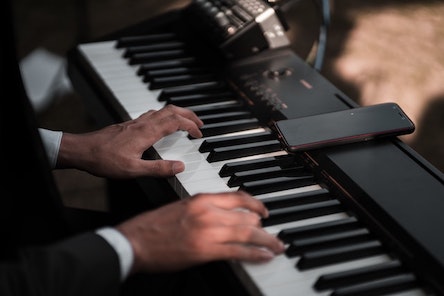Unusual Time Signatures – Tips & Tricks
 Would you like to learn how to play in unusual time signatures?
Would you like to learn how to play in unusual time signatures?
You’re in the right place.
Here’s a lesson on how to play with a very different feel from the usual fare.
This tutorial will give you the same skills that legends like Dave Brubeck and the Mahavishnu Orchestra use to navigate odd time.
Let’s get started:
Unusual Time Signatures Video:
Before we go into the lesson itself, take 3 minutes to enjoy this lesson from Steve on how to play Paul Desmond’s “Take Five“:
Now that you’ve watched the video, let’s dig deeper into handling unusual time signatures.
What Does It Take To Get Used To Unusual Time Signatures?
 There is no other way than to get used to grooving in unusual time signatures than repeated deep listening.
There is no other way than to get used to grooving in unusual time signatures than repeated deep listening.
Take time to listen to a number of examples across genres and styles.
You have encountered Paul Desmond’s “Take Five” before:
Odd meters are common in some jazz-rock fusion bands like Mahavishnu Orchestra. Check out the “Dance of Maya” which has a 10/8 groove:
In the world of European “erudite” music, there’s Igor Stravinsky’s “The Rite Of Spring”:
People from Eastern European countries like the Greeks enjoy music in odd meters a lot:
The use of complex meter is staple of progressive rock:
Lastly, if you’re into heavy music, you’ll find plenty of examples in progressive metal:
Now that you plunged yourself into odd time signatures, learn some ways on how to deal with them yourself.
How To Play in 5/4 Time
 To get started playing in odd meters, let’s look into 5/4 time first.
To get started playing in odd meters, let’s look into 5/4 time first.
We start with 5/4 time because this is the easiest odd time signature to get into.
It’s just one beat more than 4/4 a.k.a. common time.
There are a couple of ways how we can handle 5/4 time. The simplest of which is to simply count in quarter notes 1-2-3-4-5 like in “Take Five”.
Practice counting in 5 with an accent on the first beat here:
You can also try playing along with the online metronome above.
How To Simplify Counting In 5/4
 You can count 5/4 time in different ways.
You can count 5/4 time in different ways.
One way that some musicians would think of 5/4 is by counting them in eighth notes rather than quarter notes.
Additionally, you can count them in groups of 3’s and 2’s. Remember basic arithmetic?
3 + 2 = 5
Listen to this 32-bar drum sequence in 5/4. Before the drums play the groove, there is a 2-bar countoff.
While listening to the drum groove, start counting 1-2-3-1-2 as it plays:
Now, using the same drum groove, here are some fun things to practice with it:
- Play any chord progression (such as a 2-5-1) over it. Make sure to groove along the drum pattern.
- Come up with a note sequence using 5/4 time and play over the drum groove.
- Recall any of your favorite licks and modify it to fit the groove.
Changing The Way You Count Unusual Time Signatures Also Changes The Feel
Another interesting about unusual time signatures is that feel changes when we group the 8th notes differently.
For example, the main riff from “Tarkus” by Emerson, Lake, & Palmer is grouped as 1-2-3-4-1-2-3-1-2-3.
When listening to that opening riff in “Tarkus”, the accents are on the 2nd and 3rd 1’s.
By looking at 2 examples of how to count in 5/4, you have unlocked a key principle in handling complex time signatures.
One Secret To Playing In Unusual Time Signatures
 The key to playing in unusual time signatures is by subdividing the bar in groups of 2’s, 3’s, and 4’s.
The key to playing in unusual time signatures is by subdividing the bar in groups of 2’s, 3’s, and 4’s.
Isn’t that really simple?
In fact, you already have the skills to tackle odd meters.
Now is the time for you to put it to the test and practice.
How To Play in 7/8 Time
One good example of how to play in 7/8 time is the Brad Mehldau Trio’s interpretation of “Got Me Wrong” by Alice in Chains:
There are a few ways how to count over this track:
- Practice counting up to seven but use only one syllable per beat. In this instance, count One-Two-Three-Four-Five-Six-SEV.
- Notice that you substitute “sev” for “seven”. This makes counting all 7 beats clearly and evenly.
- You can simplify counting over 7/8 by counting either 1-2-3-4-1-2-3 or 1-2-1-2-1-2-3.
- If you want to count in 16th notes, use 1&-2&-3&-4&-5&-6&-SEVEN.
Now it’s time for you to try how to play in 7/8 time.
Listen to this particular drum sequence. It has a 1-2-1-2-1-2-3 feel:
Work on this time signature using the earlier suggestions on how to jam along this drum track.
Now let’s move on to something beyond 7/8.
How To Feel Time In 11/8 Like Don Ellis
If you thought that Dave Brubeck was the only guy who messed around with wacky meter, think again.
Check out this composition by trumpeter Don Ellis called “Upstart”:
To follow the meter, you’re going to count in 8th notes like this: 1-2-3-1-2-3-1-2-3-1-2.
Again, by subdividing any bar in unusual time signatures into simpler units, you can easily follow the music.
More than that, you’ll also gain the ability to play in such time signatures.
Now that you can handle complex meters, is it enough for you to succeed.
What Does It Take To Take Your Playing To The Next Level?
 Do you feel like you have wasted years training without gaining anything?
Do you feel like you have wasted years training without gaining anything?
Have you lost confidence in skills and knowledge over the years?
Perhaps you might be technically gifted, can play with flash and flair, and manage the trickiest of time signatures.
However, when pus comes to shove, you can’t improvise well enough to save your life.
You might have lost confidence in yourself, feeling like the worst musician on the planet.
I understand the frustration. I’ve been there.
The good news is that you can find help through the Jazz Inner Circle.
The Jazz Inner Circle‘s instructors are world-touring professionals, armed with practical skills that lets them play on stage with Grammy-award-winning artists.
Inside the Jazz Inner Circle, you’ll discover:
- Access to over 50 hours of high level jazz intensive workshops.
- “Jazz Piano Decade In A Day Mastermind” – A full day of personal training live.
- “The Ultimate Jazz Workout Training System.” This is where we implement a complete practice program to build your jazz piano talent in record time.
Learn world-class jazz piano secrets with us here.
I hope that this lesson has demystified unusual time signatures.
Do you have any comments, reactions, and even suggestions for the next lesson? Leave a comment below.
Still reading? It’s time to go to the piano and practice.
